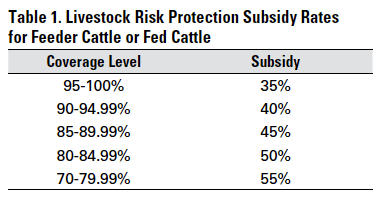Bagley Risk Management Solutions: Your Guard Versus Uncertainty
Understanding Animals Danger Defense (LRP) Insurance: A Comprehensive Overview
Browsing the world of animals threat security (LRP) insurance policy can be an intricate endeavor for many in the agricultural market. From just how LRP insurance policy functions to the different insurance coverage alternatives readily available, there is much to reveal in this comprehensive guide that can possibly form the means animals manufacturers approach risk management in their companies.

How LRP Insurance Works
Occasionally, understanding the mechanics of Animals Danger Security (LRP) insurance can be complicated, however breaking down exactly how it works can supply clearness for farmers and ranchers. LRP insurance policy is a risk monitoring tool made to secure animals producers versus unexpected rate declines. The plan allows manufacturers to set a coverage level based upon their specific requirements, choosing the number of head, weight array, and protection rate. Once the plan is in location, if market prices fall below the coverage cost, producers can submit a claim for the difference. It is essential to keep in mind that LRP insurance is not a profits guarantee; instead, it concentrates only on cost threat protection. The insurance coverage period usually ranges from 13 to 52 weeks, providing flexibility for producers to select a duration that aligns with their manufacturing cycle. By making use of LRP insurance coverage, farmers and herdsmans can reduce the monetary dangers connected with fluctuating market prices, ensuring greater stability in their operations.
Qualification and Insurance Coverage Options

When it comes to coverage alternatives, LRP insurance policy provides producers the flexibility to choose the protection degree, insurance coverage duration, and endorsements that best fit their risk administration demands. By recognizing the eligibility standards and insurance coverage alternatives offered, animals producers can make informed choices to handle danger efficiently.
Benefits And Drawbacks of LRP Insurance Policy
When reviewing Animals Risk Defense (LRP) insurance policy, it is crucial for animals producers to consider the benefits and drawbacks integral in this danger management device.

Among the primary benefits of LRP insurance is its capacity to supply security versus a decrease in livestock costs. This can assist safeguard producers from monetary losses arising from market variations. Additionally, LRP insurance coverage supplies a level of adaptability, allowing producers to personalize protection degrees and plan periods to suit their certain Discover More demands. By securing a guaranteed rate for their livestock, manufacturers can better take care of risk and prepare for the future.
One constraint of LRP insurance coverage is that it does not safeguard versus all types of threats, such as illness outbreaks or all-natural catastrophes. It is important for manufacturers to very carefully evaluate their specific danger exposure and economic circumstance to identify if LRP insurance is the ideal risk administration device for their operation.
Recognizing LRP Insurance Premiums

Tips for Making Best Use Of LRP Advantages
Making best use of the benefits of Livestock Risk Defense (LRP) insurance needs strategic preparation and proactive danger management - Bagley Risk Management. To maximize your LRP insurance coverage, take into consideration the adhering to tips:
Regularly Analyze Market Problems: Keep educated concerning market trends and price fluctuations in the livestock industry. By keeping track of these elements, you can make educated decisions regarding when to acquire LRP insurance coverage to shield versus possible losses.
Establish Realistic Protection Levels: When selecting protection levels, consider your manufacturing expenses, market price of animals, and potential risks - Bagley Risk Management. Setting reasonable protection levels guarantees that you are properly safeguarded without overpaying for unneeded insurance
Expand Your Protection: As opposed to relying only on LRP insurance, consider expanding your risk management approaches. Integrating LRP with other risk monitoring tools such as futures contracts or choices can give thorough insurance coverage versus market unpredictabilities.
Review and Readjust Protection On a regular basis: As market conditions transform, regularly review your LRP insurance coverage to ensure it straightens with your present risk direct exposure. Adjusting insurance coverage levels and timing of acquisitions can aid optimize your threat protection approach. By complying with these pointers, you can take full advantage of the benefits of LRP insurance policy and safeguard your animals procedure against unanticipated threats.
Final Thought
In conclusion, livestock threat protection (LRP) insurance coverage is a beneficial tool for farmers to handle the economic risks linked with their livestock procedures. By understanding how LRP functions, qualification and coverage alternatives, in addition to the pros and cons of browse around this site this insurance, farmers can make informed choices to secure their source of incomes. By very carefully thinking about LRP costs and applying techniques to take full advantage of advantages, farmers can alleviate potential losses and make sure the sustainability of their operations.
Animals manufacturers interested in obtaining Livestock Danger Security (LRP) insurance policy can discover an array of qualification standards and insurance coverage alternatives customized to their certain animals procedures.When it comes to protection choices, LRP insurance coverage provides producers the flexibility to choose the coverage degree, insurance coverage duration, and endorsements that best suit their threat monitoring requirements.To understand the complexities of Livestock Risk Defense (LRP) insurance policy completely, comprehending the elements influencing LRP insurance policy costs is critical. LRP insurance policy premiums are figured out by various elements, consisting of the protection level chosen, the expected rate of livestock at the end of the insurance coverage period, the type of animals being insured, and the length of the coverage duration.Review and Readjust Protection On a regular basis: As market conditions transform, regularly review your LRP insurance coverage website link to ensure it straightens with your present risk exposure.